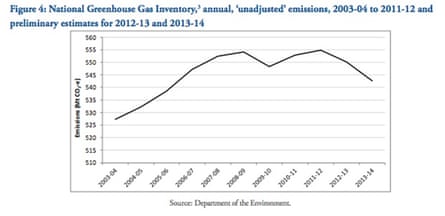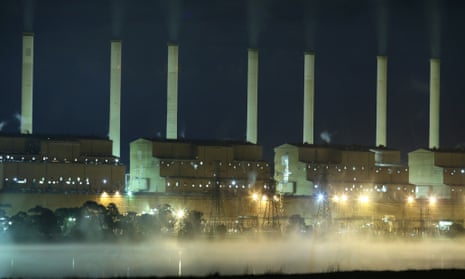Australia’s greenhouse gas emissions dropped 1.4% in the second full year of the carbon price – the largest recorded annual decrease in the past decade.
Data released by the Department of the Environment (pdf) showed that emissions in the June quarter rose 0.4%. However, annual emissions to June 2014 dropped 1.4%.
This period includes the second 12 months of the carbon pricing system, which was introduced by the previous federal government in 2012. The Coalition fulfilled an election pledge by abolishing carbon pricing in July.
Emissions reduction accelerated during the two-year span of carbon pricing, with emissions edging down by 0.8% in the first 12 months of the system.
The latest greenhouse gas inventory showed emissions from the electricity sector, the industry most affected by carbon pricing, fell 4% in the year to June.
Electricity emissions account for a third of Australia’s emissions output, which stood at 542.6m tonnes in the year to June, down from 550.2m tonnes in the previous 12 months.
Emissions from transport dropped 0.4% in the year to June, with gases released by the agriculture industry decreasing by 2.6%. Industrial processes emitted 1.3% less greenhouse gas during the year, although fugitive emissions, such as those from mining, rose 5.1%.
Electricity emissions peaked in 2008 and have steadily decreased ever since, driven by a number of factors such as the winding down of parts of Australia’s manufacturing base and energy efficiency initiatives.

The Greens leader, Christine Milne, said: “These figures demonstrate to the rest of the world just how effective our carbon price was at bringing down pollution. This is the biggest ever drop recorded and the price made it happen.
“The Abbott government will go down in history as taking the biggest backward step in tackling global warming Australia has ever seen. As well as being terrible for the climate, it is a tragedy for Australia in terms of lost investment and jobs in the clean industries of the future.”
Victoria McKenzie-McHarg, the climate change program manager at the Australian Conservation Foundation, said the figures demonstrated the carbon price was effective.
“We’ve never seen a decrease like this. Yes, there was a lot else happening in this time, but it is an indication that the policy was working,” she said.
“The price did better than expected. Also, we would have seen deeper cuts in emissions over time as the price created a long-term economic signal and changed investment in energy. We never expected to see the biggest reductions straight away.”
The Coalition’s emissions reduction fund, a $2.55bn initiative that will provide voluntary grants to businesses that want to reduce their emissions, will begin distributing cash via reverse auctions in the first quarter of next year.
The government’s Climate Change Authority said this week it was “unlikely” the new policy would meet Australia’s minimum goal of a 5% reduction in emissions by 2020, on 2000 levels. The analysis followed similar pessimism raised by the UN and independent bodies about the new regime.
McKenzie-McHarg said: “It is difficult to see how it will deliver the required cuts. It takes money from taxpayers and gives it to polluters. This reverses the longstanding principle of polluter pays, which sets a dangerous and expensive precedent.”
The Coalition has maintained that the carbon price delivered minimal emissions cuts at a large cost to the economy and household electricity bills. The government estimates the repeal of the system saves the average household about $550 a year.
The environment minister, Greg Hunt, said Australia’s emissions trajectory was going down, making him confident the 5% cut goal would be met through bids for carbon abatement money.
“I am not just confident, I am exceptionally confident that we’ll achieve our targets,” he told Sky News. “And a couple of very significant things have occurred.
“We see that there is a lower trajectory than expected. I also note that the pipeline of likely bids is far higher than we had anticipated or expected. Material that wasn’t before the Climate Change Authority. And so we are in better shape than I had ever hoped at this stage. And I’m very pleased.”
The next set of quarterly emissions figures will be released in February. Interim data, released by consultancy firm Pitt&Sherry, has shown Australia’s emissions have increased since the repeal of the carbon price.
A spokesman for Hunt told Guardian Australia: “We are determined to cut emissions without a carbon tax that hurts Australian families and business.
“In its two years of operation, the world’s largest carbon tax was a $15.4b burden on the Australian economy. Despite the $7.8b carbon tax burden, emissions barely changed in 2013-14.
“The majority of the decline in emissions was the result of declining electricity demand as Australia lost major manufacturing industries under Labor.
“Electricity consumption has dropped over the past five consecutive years – before the carbon tax, during the carbon tax, and after the carbon tax.”

Comments (…)
Sign in or create your Guardian account to join the discussion